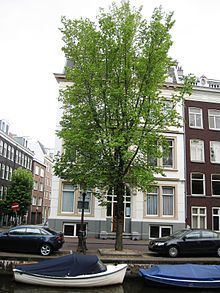Cultivar 'Plantyn' | ||
 | ||
Hybrid parentage ('Exoniensis' × U. wallichiana) × (U. minor '1' × U. minor '28') Similar Ulmus 'Plinio', Ulmus 'Groeneveld', Ulmus 'Fiorente', Ulmus minor 'Schuurhoek', Ulmus minor 'Purpurascens' | ||
Ulmus 'Plantyn' (Anglicized form of 'Plantijn') was one of three Dutch hybrid elms released in 1973. Derived from a crossing of the Dutch hybrids '202' (U. 'Exoniensis' × U. wallichiana) and '302' (U. minor '1' × U. minor '28'), it was to prove of great significance in later developments. A selfed seedling was to become the first Dutch clone to prove effectively immune to disease, released in 1989 as 'Columella'. 'Plantyn' was also destined to be the female parent of Lutèce released in 2002. In Italy, 'Plantyn' was used again as female parent in hybridizations with the Siberian Elm Ulmus pumila by the Istituto per la Protezione delle Piante (IPP), to create three new cultivars better adapted to the Mediterranean climate (see Hybrid cultivars).
Contents
Description
'Plantyn' is a fast-growing tree, with upright branching forming a broad crown where grown in isolation. The dark-green leaves are < 10 cm long by 7 cm broad, on < 10 mm petioles.
Pests and diseases
'Plantyn' is no more resistant to Dutch elm disease than its Dutch contemporaries 'Dodoens' and 'Lobel' according to one source, rating 4 out of 5. However, research published in France by the Institut National de la Recherche Agronomique (INRA) indicated that 'Plantyn' possesses a greater degree of disease resistance than the other two cultivars, although neither had actually been tested by the organization. Nevertheless, INRA still classified 'Plantyn' as only 'moderately resistant'.
Cultivation
Largely superseded by the later generation of cultivars highly resistant to Dutch elm disease, sales in the Netherlands declined from over 7,000 in 1979 to zero in 2004 [1]. Like its Dutch contemporaries, 'Plantyn' has proven very tolerant of sea winds.
'Plantyn' was not commercially released in the USA, but was evaluated at the Iowa State University (acc. no. Q 28835) however it is no longer listed (2013) in the NPGS inventory. 'Plantyn' was also included in trials [2] in Canberra, Australia, started in 1988, although it is reputed not to have thrived in that environment.
Notable trees
The TROBI [3] UK champion is at West Park, Wolverhampton, which had attained a height of 17 m and a d.b.h. of 54 cm by 2004. Another grows in Kensington Gardens, London, which was 16 m high, 45 cm d.b.h. in 2001.
Cultivars
Hybrid cultivars
Etymology
The tree is named for the French printer and humanist Christoffel Plantijn (France: Christophe Plantin).
Synonymy
'Plantijn' (original Dutch form of the name).
The tag on the specimen at Kew Gardens reads 'Plantion'.
